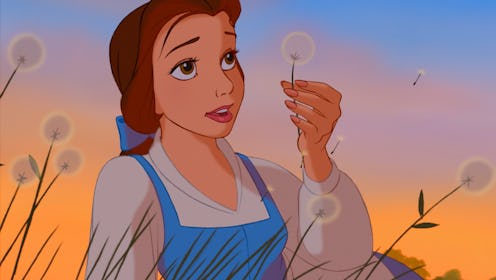
If, like myself, you grew up a fan of the films that came out of the '90s Disney Renaissance, then Linda Woolverton is a name you should know. Having written the screenplays for Beauty and the Beast and Homeward Bound: The Incredible Journey, co-written The Lion King, and provided story input for Mulan, Woolverton's words featured heavily in many childhood favorites. More recently, the writer has worked on live-action adaptations of Disney films, writing 2010's Alice in Wonderland and 2014's Maleficent. This year, Woolverton wrote Alice Through the Looking Glass , and she's currently working on the Maleficent sequel. With a resume like that, it's clear that Woolverton is responsible for some of Disney's biggest and best female characters — yet talking to Bustle, the writer says that when she started working on her first film, Beauty and the Beast , it was a challenge to convince studios to change their idea of what a Disney princess could be.
"I just was coming out of the women's movement. I just didn't think that we as women and girls would accept that sort of throwback heroine who is symbolic of her time," Woolverton says. "[There's] nothing wrong with that, but that was no longer who we were as women and girls and it wouldn't feel true. It would just feel like a throwback."
Disney had gone through a number of script revisions on Beauty before Woolverton was brought on. In the version of the script that she was handed, one scene saw Belle decorating a cake — something the writer fought against, eventually changing it to Belle reading a book. From the get-go, Woolverton proposed significant alterations to the script, particularly to Belle. "I was really pushing pushing pushing the envelope with Disney to try to break free of that pair old paradigm," Woolverton says now. "It was hard, I gotta say."
Particularly challenging was the way that Disney, at the time, viewed their heroines, Woolverton says. "They just sort of had to be pushed beyond the old perception of what a Disney heroine is, and that wasn't an easy task," she explains. "Howard Ashman, who was a lyricist for the movie, was really beneficial at really helping. We basically created Belle together. We decided we weren't going to do the old heroine. We were going to do a thinker and a reader and a bit of a brave courageous young woman who is different than the other people in her little town."
Disney fans will notice that after Belle, no princess was written as weak or incapable. They're all fiercely independent and strong, and Woolverton says she feels tremendous pride about playing a part in that change. "It is very gratifying, honestly, and I think [if Beauty] had done badly, nothing would have changed," she says. "But it didn't. And it won critical acclaim and Academy Award nominations so that sort of signaled [that] there's an acceptance of this kind of a Disney heroine. And so they just kind of kept going from there."
Belle is now heading into live-action territory herself with next year's Beauty and the Beast adaptation, starring Emma Watson. Though she isn't involved with the film, Woolverton does have a story credit, as the characters are her creations. When asked how it felt to let other screenwriters take over her characters, Woolverton seems at ease with the change, something she's witnessed before. "It's always like, you create a character you love and then you have to love them enough to put their heart and soul and your guts and everything to make them seem true, but there's a certain point you have to let it go because it doesn't even belong to me."
Still, she adds, "I can't say it's not hard. It's hard every single time."
Although directing her own work could possibly ease that pain, Woolverton isn't looking to switch professions anytime soon. "I thought about it for a long time because it's really the only way to keep making any kind of control over your work in the way that this business works," she says. "But I also look at my skill set and, I'm not a general. I don't command troops, that's not my personality. I'm more like the wizard in the corner making things up. So I kind of have to come to terms with that about myself and understand what I am good at and probably what I wouldn't be so good at."
That said, she does have words for Disney, Pixar, and other studios lacking female directors. Disney Animation Studios can only boast Jennifer Lee of Frozen, and Pixar only has Brenda Chapman of Brave — both of whom were co-directors alongside male counterparts. "It's not just Disney — the whole industry needs their hands slapped about the lack of female directors," Woolverton says. "Independent films have a lot of females but [studios] are not throwing all of this money at them. And their distrust of women! That they're not trusting them with these huge tentpole, very expensive films... I'm hoping that can change."
And with a woman in charge of the camera, Woolverton adds, the films being made could be entirely different than what audiences are used to. "The director's vision and style and tone and decisions permeate every single choice in the movie. So if a woman is directing, it's going to be a different movie than if a man were there to direct it. I really believe that we need that," she says. "The difference is a view of the world that is equal. 50% of the world is female."
As one of the many young women lucky enough to have grown up with Belle as a role model, I can confirm that having a woman influence a film's story makes all the difference.
Images: Disney, Giphy